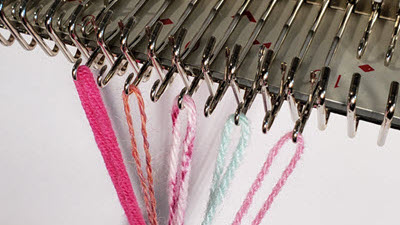
Essential Yarn Guide for Machine Knitters
Learn about yarn types, tips, and a handy chart to help you choose the perfect yarn for your machine knitting projects

Learn about yarn types, tips, and a handy chart to help you choose the perfect yarn for your machine knitting projects
Just because a yarn says "DK weight" or "fingering" doesn't mean it'll work smoothly with your machine. Unlike hand knitting, machine knitting demands yarn that glides across needles without excessive resistance or slippage. It’s not just about weight - it’s about behavior.
Cone yarn is made for machine knitting - consistent, often waxed, and ready to go. But don’t rule out yarn in balls or skeins. With the right setup (think tension mast and careful winding), they’re usable too.
Ignore the "recommended needle size" and instead swatch with your machine. Yarn labels are for hand knitting. Gauge rules everything in machine knitting.
We can’t say it enough: Always knit and measure a swatch. Even cone yarns behave differently based on fiber content, humidity, and machine condition.
The perfect yarn for one knitter might be a nightmare for another. Get to know how your machine behaves with different yarns. Build your own stash of trusted yarns. And above all - swatch.
Smooth, consistent, tightly-spun yarns work best — especially those sold on cones, which are designed for machine use. Avoid yarns with slubs or excessive fuzz.
Yes, but expect to swatch and experiment. Hand knitting yarn can work well if it's rewound properly and behaves consistently through the machine.
This usually points to poor yarn quality, dryness, static, or improper tension. Try waxing the yarn or adjusting how it’s fed into the machine.
Absolutely. Every yarn behaves differently on the machine. Swatching helps avoid wasted time and materials and ensures your garment will fit as expected.
Cone yarn is often waxed, wound for tension consistency, and designed to flow smoothly through a knitting machine. Regular yarn in balls can be used, but may require rewinding and more attention.
| Symbol | Category | Yarn Types | Yards Per Pound | 4" (10cm) | Machine/Pitch | UK | AUS | Hand Knitting Needle Size |
|---|---|---|---|---|---|---|---|---|
| Lace | Lace Fingering 2-ply 10-count crochet thread |
4000 - 10,000 ypp | 33-40 sts | Standard 4.5mm (stranded) |
1 ply | 2 ply | 1.5 - 2.2mm | |
| Super fine | Sock Fingering Baby 3-ply |
3000-4000 ypp | 27-32 sts | Standard 4.5mm (stranded) |
2 ply | 3 ply | 1.25 - 3.5mm | |
| Fine | Sport Baby 4-ply |
2000-3000 ypp | 23-26 sts | Standard 4.5mm / Double Bed |
4 ply | 5 ply | 3.5 - 4.5mm | |
| Light | DK Light worsted |
1000-2000 ypp | 21-24 sts | Mid-Gauge 6.0 |6.5| 7mm/Standard 4.5mm |
DK | 8 ply | 4.5 - 5.5mm | |
| Medium | Worsted Afghan Aran |
800-1000 ypp | 16-20 sts | Mid-Gauge 6.0 |6.5| 7mm/Bulky 9mm |
Aran | 10 ply | 5.5 - 6.5mm | |
| Bulky | Chunky Craft Rug |
500-800 ypp | 12-15 sts | Bulky 9mm |
Chunky | 12 ply | 6.5 - 9mm | |
| Super Bulky | Super bulky Roving |
100-500 ypp | 6-11 sts | May not be appropriate | Super Chunky | 14 ply | 9mm + |
I get confused with coned yarn weights because the numbering system doesn't make sense to me. And then it's completely different for cotton yarns. I usually buy a shade card for coned yarns so I can also feel the texture and see if I need to double it triple strand.